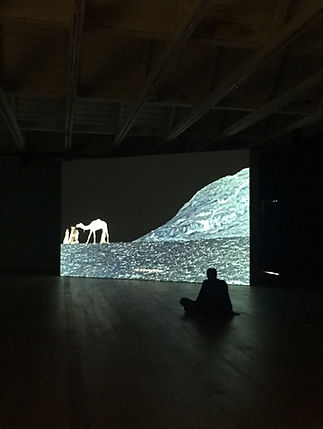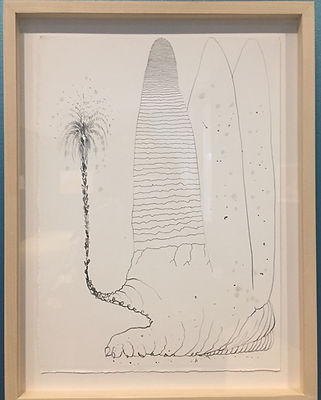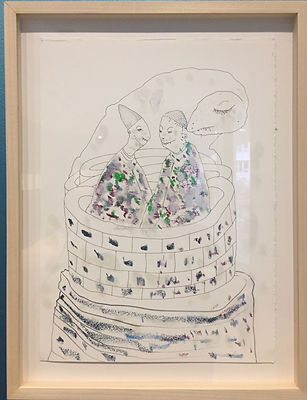Fact or Fiction?
by Josie Dawson-Whisker
The distinction between history and mythology can at times be hard to pinpoint. Both set out to recount traditional stories of the past, however one undoubtedly has more validity than the other in modern-day society. Wael Shawky’s exhibition at the Polygon Gallery in North Vancouver captivatingly combines historical and mythological elements to question the idea of memory and storytelling, presenting a cultural exploration into the lives of the Egyptians. Al Araba Al Madfuna showing from October 18th to January 12th 2020 features filmic, sculptural and illustrative components. The result is an immersive experience that inspires further research and questions about the memories of Egyptian history.
The exhibition can be found on the second floor of the gallery upon which we enter
through a closed door into a large, dimly lit room with deep blue walls. The room feels
almost empty with only three artworks and rather solemn with the only light being those that showcase them. Nevertheless, there is immediate recognition of the Egyptian culture. To the right is a towering, freestanding wall illuminated by the projection of a video. It is a film that features characters dressed in modern Egyptian robes and turbans, traveling across the barren landscape while recounting a story in presumably the Egyptian language with English subtitles along the bottom. In the far left corner diagonally across from the film, precariously yet elegantly sits a mound of pale white sand, sparkling under the glow of the light. About halfway between the pile and the door from which we just entered is a glass table vitrine containing plaster figurines of ancient Egyptian deities on top of a layer of the same pale desert-like sand. Small circular lights have been installed in the vitrine to light these figures from above while reflections of the film and of the sand can be seen in its glass walls. This layout calls to their representation as ancient artefacts. Finally, to the far right side of the space is another door leading into a more brightly and naturally lit room. Entering the room, we find a collection of figurative drawings that have been framed and hung along the walls, whose depictions coincide with the previously established theme of Egyptian culture.


Wael Shawky, Installation view of Al Araba Al Madfuna. Photo by Josie Dawson-Whisker.
The openness of the first room invites an audience to sit back and watch the projected film, invoking similar feelings of being in a theatre. At the same time, the looping of the video allows us to come and go as we please. The fact that it is not a one-time screening, one does not feel obliged to absorb every detail in one sitting. What is at once noticeable is the inverted colour of the film. We are confronted with bizarre and unfamiliar visuals full of highly contrasted blacks and whites with splashes of blues, purples, oranges, greens and yellows. We then follow a group of young children characters, dressed with full bushy moustaches, on along journey in the desert, between mountains, through marshes, across villages, and throughout ancient architecture. One of the young boys poetically recounts a story, but peculiarly through the deep voice of an adult male. Although we may not be able to take in an exact logical storyline, a topic that repeatedly comes up is the importance of the sunflower seed, specifically of its move from inferiority in relation to other crops to its wide use of medicinal cures. Layered within the story are the hypnotizing musical sounds of an organ, drums, bells, water, and layered tones that call to the Egyptian lifestyle. The atmosphere of the film seems to set that of the whole exhibition. Completely mystical and mesmerizing!

Wael Shawky, Al Araba Al Madfuna III, 2016. 4K video, 27 min. Photo by Josie Dawson-Whisker.

Wael Shawky, Al Araba Al Madfuna: Untitled. Photo by Josie Dawson-Whisker.
At first glance at the figurines we can recognize certain gods or goddesses from Egyptian mythology such as the Sphinx, Anubis, Sekhmet or Apep (1). However, when we start to look harder, different ones seem to be hybridized together forcing us to question the stories put in place about these deities. Similar questions arise for Shawky’s drawings. Are they creatures from ancient mythology or is he conjuring up his own myths? Reading the wall text about this exhibition gives us a better understanding of the works, specifically the video. “We see children acting out one story while recounting another in adult voices” (2) while the inspiration for the film comes from Egyptian writer Mohamed Mustagab’s short story “Sunflowers”(3). Does this film then give a direct recounting of this short story or has Shawky rewritten its history? Through the realization of this double storytelling, we become aware of the surrealist quality of the video. The more we watch, the more bizarrely the physical story and the audible story seem to fit (or not fit) together. As a whole, “Shawky’s dreamlike retelling highlights the fallibility of memory, and brings real and metaphysical experiences into provocative dialogue” (4).

Wael Shawky, Al Araba Al Madfuna: Sculptures, 2018. Oil, pigment, graphite on plaster. Photo by Josie Dawson-Whisker.


Wael Shawky, Al Araba Al Madfuna: Drawings, 2015-2018. Ink, oil, pigment on paper. Photo by Josie Dawson-Whisker.
Overall, Shawky’s exhibition was an interesting way to play with the distinguishing factors between mythology and history, at the same time giving the audience a glimpse of Egyptian culture. We are left with uncertainty as to the truth of these stories. Do these artworks represent actual historical events? Mythological stories that have been passed down? Or maybe Shawky has blended these two concepts to create his own stories of the past? Despite their validity, Shawky has presented us with multiple ways that history is recounted: through artefacts, direct storytelling passed down from older generations to younger generations, physical books and drawings, and connection to the land and culture. My one hope is that our notions of history do not end up like those in George Orwell’s book 1984 in which history is constantly being rewritten by the hierarchy and people’s memories of the past are disregarded (5). We do not want to live in a world where history is a lie and memories are lost, leaving us with the question of what is really the truth and what is myth.
1. Wikipedia. “List of Egyptian Deities.” Wikipedia. https://en.wikipedia.org/wiki/List_of_Egyptian_deities (retrieved October 27, 2019)
2. Wall text, The Polygon Gallery, Al Arab Al Madfuna, North Vancouver, BC.
3. Wall text, The Polygon Gallery, Al Arab Al Madfuna, North Vancouver, BC.
4. Wall text, The Polygon Gallery, Al Arab Al Madfuna, North Vancouver, BC.

